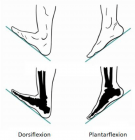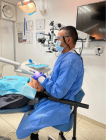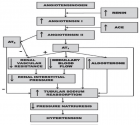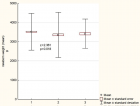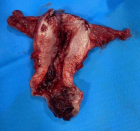Abstract
Research Article
Investigation of Retinal Microvascular Findings in patients with Coronary Artery Disease
Tolga Doğan*, Osman Akın Serdar, Naile Bolca Topal and Özgür Yalçınbayır
Published: 07 July, 2017 | Volume 2 - Issue 1 | Pages: 042-049
Objectives: Retinal microvascular anomalies may be a marker for cardiovascular diseases. Our aim in this study was to investigate the utility of ocular fundoscopic examination as a noninvasive method in specifying the patients who carry a risk for coronary artery disease.
Material and Method: Patients who were diagnosed with coronary artery disease by coronary angiography were included in our study. Bilateral fundoscopic examination was performed in these patients. Fundoscopic findings and risk factors for coronary artery disease were evaluated.
Results: This study enrolled 100 patients (male: 72 (72%), mean age: 58.25±7.1) who were diagnosed with coronary artery disease by coronary angiography. Upon fundoscopic examination, 87% of the study population had atherosclerotic changes. Grade I atherosclerosis was found in 54% of the patients, grade II atherosclerosis was found in 32% of the patients and grade III atherosclerosis was found in 1% of the patients. Increased retinal tortuosity was present in 65% of the patients. Hollenhorst plaque was observed in 3 patients. Drusenoid bodies were observed with a statistically significantly higher rate in the patients who were not using clopidogrel compared to the patients who were using clopidogrel (p<0.001).
Conclusions: Retinal findings are frequently found in patients with coronary artery disease. Therefore, fundoscopic examination is a noninvasive and feasible examination method which can be frequently used in the evaluation of cardiac functions.
Read Full Article HTML DOI: 10.29328/journal.jccm.1001012 Cite this Article Read Full Article PDF
Keywords:
Coronary artery disease; Fundoscopic examination; Atherosclerosis
References
- Bonow RO, Smaha LA, Smith SC Jr, Mensah GA, Lenfant C. World Heart Day 2002: the international burden of cardiovascular disease: responding to the emerging global epidemic. Circulation. 2002; 106: 1602-1605. Ref.: https://goo.gl/QLe28G
- 2nd World Health Report 1999: Making a difference. Geneva: World Health Organization; 1999.
- Goto I, Katsuki S, Ikui H, Kimoto K, Mimatsu T. Pathological studies on the intracerebral and retinal arteries in cerebrovascular and noncerebrovascular diseases. Stroke. 1975; 6: 263-269. Ref.: https://goo.gl/vfNrvL
- Tedeschi-Reiner E, Strozzi M, Skoric B, Reiner Z. Relation of atherosclerotic changes in retinal arteries to the extent of coronary artery disease. Am J Cardiol. 2005; 96: 1107-1109. Ref.: https://goo.gl/USq7Uc
- Baim DS, Grossmann W. Coronary Angiography. In: Baim Grossmann, editor. Grossman’s Cardiac Catheterization, angiography, and Intervention. 6th ed. Philadelphia: Lippincott Williams and Wilkins; 2000; 211-257.
- Friedewald WT, Levy RI, Fredrickson DS. Estimation of the concentration of low-density lipoprotein cholesterol in plasma, without use of the preparative ultracentrifuge. Clin Chem. 1972; 18: 499-502. Ref.: https://goo.gl/e2Nb9g
- Apple DJ, Naumann GO. Retina, In: Naumann GO, Apple DJ (eds). Pathology of the Eye. New York; Springer-Verlag; 1986; 580-583.
- Tedeschi-Reiner E, Strozzi M, Skoric B, Reiner Z. Relation of atherosclerotic changes in retinal arteries to the extent of coronary artery disease. Am J Cardiol. 2005; 96: 1107-1109. Ref.: https://goo.gl/KEskQ9
- Torpy JM, Glass TJ, Glass RM. JAMA patient page. Retinopathy. JAMA. 2005; 293: 128. Ref.: https://goo.gl/c4pwhU
- Cheung N, Bluemke DA, Klein R, Sharrett AR, Islam FM, et al. Retinal arteriolar narrowing and left ventricular remodeling: the multi-ethnic study of atherosclerosis. J Am Coll Cardiol. 2007; 50: 48-55. Ref.: https://goo.gl/e62Arb
- Lang GK. Ophthalmology: A Pocket Textbook Atlas. (Thieme, Stuttgart, 2007).
- Kelin R. Epidemiology. In age-related macular degeneration. In: Berger JW, Fine SL, Maguire MG. Eds. Philadelphia: Mosby. 1999; 31-55.
- Klein R, Klein BE, Linton KL, DeMets DL. The Beaver Dam Eye Study: the relation of age-related maculopathy to smoking. Am J Epidemiol. 1993; 137: 190-200. Ref.: https://goo.gl/Pnadtb
- Smith W, Mitchell P, Leeder SR. Smoking and age-related maculopathy. The Blue Mountains Eye Study. Arch Ophthalmol. 1996; 114: 1518-15123. Ref.: https://goo.gl/EBmPbX
- Christen WG, Glynn RJ, Ajani UA, Schaumberg DA, Chew EY, et al. Age-related maculopathy in a randomized trial of low-dose aspirin among US physicians. Arch Ophthalmol. 2001; 119: 1143-1149. Ref.: https://goo.gl/GcBGYG
- Cymerman RM, Skolnick AH, Cole WJ, Nabati C, Curcio CA, et al. Coronary Artery Disease and Reticular Macular Disease, a Subphenotype of Early Age-Related Macular Degeneration. Curr Eye Res. 2016; 41: 1482-1488. : https://goo.gl/YpiKih
- Ertugrul A. Diffuse tortuosity and lengthening of the arteries. Circulation. 1967; 36: 400-407. Ref.: https://goo.gl/hJE7ww
- Soikkonen K, Wolf J, Hietanen J, Mattila K. Three main arteries of the face and their tortuosity. Br J Oral Maxillofac Surg. 1991; 29: 395-398. Ref.: https://goo.gl/fx5MG6
- Dobrin PB, Schwarcz TH, Baker WH. Mechanism of arterial and aneurysmal tortuosity. Surgery. 1988; 104: 568-571. Ref.: https://goo.gl/DWGbqU
- Zegers ES, Meursing BTJ, Zegers EB. A.J.M oude ophuis coronary tortuosity: a long and winding road. Neth Heart J. 2007; 15: 191-195.
- Leipzig TJ, Dohrmann GJ. The tortuosity or kinked carotid artery: pathogenesis and clinical considerations. Surg Neurol. 1986; 25: 478-486. Ref.: https://goo.gl/w9NvFh
- Weibel J, Fields WS. Tortuosity, coiling, and kinking of the internal carotid artery: etiology and radiographic anatomy. Neurology. 1965; 15: 7-18. Ref.: https://goo.gl/3rtiFG
- Del Corso L, Moruzzo D, Conte B, Agelli M, Romanelli AM, et al. Tortuosity, kinking, and coiling of the carotid artery: expression of atherosclerosis or aging? Angiology. 1998; 49: 361-371. Ref.: https://goo.gl/ZwVtMa
- Zegers ES, Meursing BT, Zegers EB, Oude Ophuis AJ. Coronary tortuosity: a long and winding road. Neth Heart J. 2007; 15: 191-195. Ref.: https://goo.gl/PcfZVY
- Del Corso L, Moruzzo D, Conte B, Agelli M, Romanelli AM, et al. Tortuosity, kinking, and coiling of the carotid artery: expression of atherosclerosis or aging? Angiology. 1998; 49: 361-371. Ref.: https://goo.gl/ZwVtMa
- Owen CG, Rudnicka AR, Nightingale CM, Mullen R, Barman SA, et al. Retinal arteriolar tortuosity and cardiovascular risk factors in a multi-ethnic population study of 10 year old children; the Child Heart And health Study in England. Arterioscler Thromb Vasc Biol. 2011; 31: 1933-1938. Ref.: https://goo.gl/z6BBHh
- Brown GC, Magargal LE. Central retinal artery obstruction and visual acuity. Ophthalmology. 1982; 89: 14-19. Ref.: https://goo.gl/JfGTwF
- David NJ, Klintworth GK, Frieldberg SJ, Dillon M. Fetal Atheromatous cerebral embolism associated with bright plaques in the retinal arterioles. Report of a case. Neurology. 1963; 13: 708-713. Ref.: https://goo.gl/XmP6AL
- Hollenhorst RW, Lensink ER, Whisnant JP. Experimental Embolization of the Retinal Arterioles. Trans Am Ophthalmol Soc. 1962; 60: 316-334. Ref.: https://goo.gl/ryZffo
- Scolari F, Bracchi M, Valzorio B, Movilli E, Costantino E, et al. Cholesterol atheromatous embolism: an increasingly recognized cause of acute renal failure. Nephrol Dial Transplant. 1996; 11: 1607-1612. Ref.: https://goo.gl/pNArPE
- Poli A, Tremoli E, Colombo A, Sirtori M, Pignoli P, et al. Ultrasonographic measurement of the common carotid arterial wall thickness in hypercholestrolemic patients. Athresclerosis.1988; 70: 253-261. Ref.: https://goo.gl/FgjVC4
- Chambless LE, heiss G, Folsom Ar, rosamond W, Szklo M, et al. Association of coronary heart disease incidence with carotid arterial wall thickness and major risk factors: the Atherosclerosis Risk in Communities (ARIC) Study, 1987-1993. Am J Epidemiol. 1997; 146: 483-494. Ref.: https://goo.gl/ruU6GR
- P Nikic, M Savic, V Jakovljevic, D Djuric. Carotid atherosclerosis, coronary atherosclerosis and carotid intima-media thickness in patients withischemic cerebral disease: Is there any link? Exp Clin Cardiol. 2006; 11: 102-106. Ref.: https://goo.gl/q45uLs
Figures:
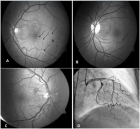
Figure 1
Similar Articles
-
Indications and Results of Coronarography in Senegalese Diabetic Patients: About 45 CasesNdao SCT*,Gaye ND,Dioum M,Ngaide AA,Mingou JS,Ndiaye MB, Diao M,Ba SA. Indications and Results of Coronarography in Senegalese Diabetic Patients: About 45 Cases. . 2017 doi: 10.29328/journal.jccm.1001007; 2: 013-019
-
Spontaneous rupture of a giant Coronary Artery Aneurysm after acute Myocardial InfarctionOğuzhan Çelik,Mucahit Yetim,Tolga Doğan,Lütfü Bekar,Macit Kalçık*,Yusuf Karavelioğlu. Spontaneous rupture of a giant Coronary Artery Aneurysm after acute Myocardial Infarction. . 2017 doi: 10.29328/journal.jccm.1001009; 2: 026-028
-
Investigation of Retinal Microvascular Findings in patients with Coronary Artery DiseaseTolga Doğan*,Osman Akın Serdar,Naile Bolca Topal,Özgür Yalçınbayır. Investigation of Retinal Microvascular Findings in patients with Coronary Artery Disease. . 2017 doi: 10.29328/journal.jccm.1001012; 2: 042-049
-
Value of electrocardiographic T wave inversion in lead aVL in prediction of Mid Left Anterior Descending Stenosis in patients with stable Coronary Artery diseaseGehan Magdy*,Awad Yousef. Value of electrocardiographic T wave inversion in lead aVL in prediction of Mid Left Anterior Descending Stenosis in patients with stable Coronary Artery disease. . 2017 doi: 10.29328/journal.jccm.1001015; 2: 056-062
-
Lipid-induced cardiovascular diseasesSumeet Manandhar,Sujin Ju,Dong-Hyun Choi,Heesang Song*. Lipid-induced cardiovascular diseases. . 2017 doi: 10.29328/journal.jccm.1001018; 2: 085-094
-
Is secondary prevention information before discharge adequate after percutaneous coronary intervention?Catrin Henriksson*,Joep Perk. Is secondary prevention information before discharge adequate after percutaneous coronary intervention?. . 2019 doi: 10.29328/journal.jccm.1001034; 4: 012-020
-
Cardiomyopathies - The special entity of myocarditis and inflammatory cardiomyopathyFelicitas Escher*,Uwe Kühl,Dirk Lassner,Heinz-Peter Schultheiss. Cardiomyopathies - The special entity of myocarditis and inflammatory cardiomyopathy. . 2019 doi: 10.29328/journal.jccm.1001041; 4: 053-070
-
Plaque morphology in diabetic vs. non diabetic patients assessed by Multi-Slice Computed Tomography coronary angiographyHesham Mohamed Aboul-Enein,Amr Elsayed El Naggar,Shereen Ibrahim Farag,Waleed Atef Ahmed Hassan*. Plaque morphology in diabetic vs. non diabetic patients assessed by Multi-Slice Computed Tomography coronary angiography. . 2019 doi: 10.29328/journal.jccm.1001057; 4: 150-155
-
Long-Term Impact of Coronary Artery Disease in Lung TransplantationWilliam S Ragalie,Nilto C de Oliveira,Richard Cornwell,Keith Meyer,James D Maloney*. Long-Term Impact of Coronary Artery Disease in Lung Transplantation. . 2019 doi: 10.29328/journal.jccm.1001073; 4: 227-232
-
Dapt ReviewKARACA Özkan*,KARASU Mehdi,KOBAT Mehmet A,KIVRAK Tarık. Dapt Review. . 2020 doi: 10.29328/journal.jccm.1001088; 5: 060-066
Recently Viewed
-
Exophthalmos Revealing a Spheno Temporo Orbital MeningiomaHassina S*, Krichene MA, Hazil Z, Bekkar B, Hasnaoui I, Robbana L, Bardi S, Akkanour Y, Serghini L, Abdallah EL. Exophthalmos Revealing a Spheno Temporo Orbital Meningioma. Int J Clin Exp Ophthalmol. 2024: doi: 10.29328/journal.ijceo.1001055; 8: 001-003
-
Value of electrocardiographic T wave inversion in lead aVL in prediction of Mid Left Anterior Descending Stenosis in patients with stable Coronary Artery diseaseGehan Magdy*,Awad Yousef. Value of electrocardiographic T wave inversion in lead aVL in prediction of Mid Left Anterior Descending Stenosis in patients with stable Coronary Artery disease. J Cardiol Cardiovasc Med. 2017: doi: 10.29328/journal.jccm.1001015; 2: 056-062
-
Calciphylaxis in HemodialysisLuca Sgarabotto*, Paola Baldini Anastasio, Nicola Marchionna, Monica Zanella. Calciphylaxis in Hemodialysis. J Clini Nephrol. 2023: doi: 10.29328/journal.jcn.1001107; 7: 044-046
-
Metabolic syndrome: A case reportDragan Klaric,Marta Martinis*,Marta Klaric. Metabolic syndrome: A case report. Ann Clin Endocrinol Metabol. 2021: doi: 10.29328/journal.acem.1001022; 5: 031-035
-
Utilization of Molecular Simulation Applications for Stability Testing of Anthocyanin Compounds in Black ElderberryRichard Benedict*. Utilization of Molecular Simulation Applications for Stability Testing of Anthocyanin Compounds in Black Elderberry. Arch Biotechnol Biomed. 2023: doi: 10.29328/journal.abb.1001035; 7: 012-017
Most Viewed
-
Evaluation of Biostimulants Based on Recovered Protein Hydrolysates from Animal By-products as Plant Growth EnhancersH Pérez-Aguilar*, M Lacruz-Asaro, F Arán-Ais. Evaluation of Biostimulants Based on Recovered Protein Hydrolysates from Animal By-products as Plant Growth Enhancers. J Plant Sci Phytopathol. 2023 doi: 10.29328/journal.jpsp.1001104; 7: 042-047
-
Sinonasal Myxoma Extending into the Orbit in a 4-Year Old: A Case PresentationJulian A Purrinos*, Ramzi Younis. Sinonasal Myxoma Extending into the Orbit in a 4-Year Old: A Case Presentation. Arch Case Rep. 2024 doi: 10.29328/journal.acr.1001099; 8: 075-077
-
Feasibility study of magnetic sensing for detecting single-neuron action potentialsDenis Tonini,Kai Wu,Renata Saha,Jian-Ping Wang*. Feasibility study of magnetic sensing for detecting single-neuron action potentials. Ann Biomed Sci Eng. 2022 doi: 10.29328/journal.abse.1001018; 6: 019-029
-
Pediatric Dysgerminoma: Unveiling a Rare Ovarian TumorFaten Limaiem*, Khalil Saffar, Ahmed Halouani. Pediatric Dysgerminoma: Unveiling a Rare Ovarian Tumor. Arch Case Rep. 2024 doi: 10.29328/journal.acr.1001087; 8: 010-013
-
Physical activity can change the physiological and psychological circumstances during COVID-19 pandemic: A narrative reviewKhashayar Maroufi*. Physical activity can change the physiological and psychological circumstances during COVID-19 pandemic: A narrative review. J Sports Med Ther. 2021 doi: 10.29328/journal.jsmt.1001051; 6: 001-007

HSPI: We're glad you're here. Please click "create a new Query" if you are a new visitor to our website and need further information from us.
If you are already a member of our network and need to keep track of any developments regarding a question you have already submitted, click "take me to my Query."






